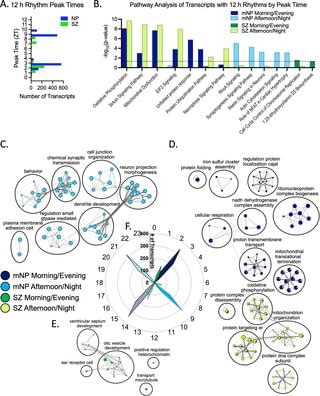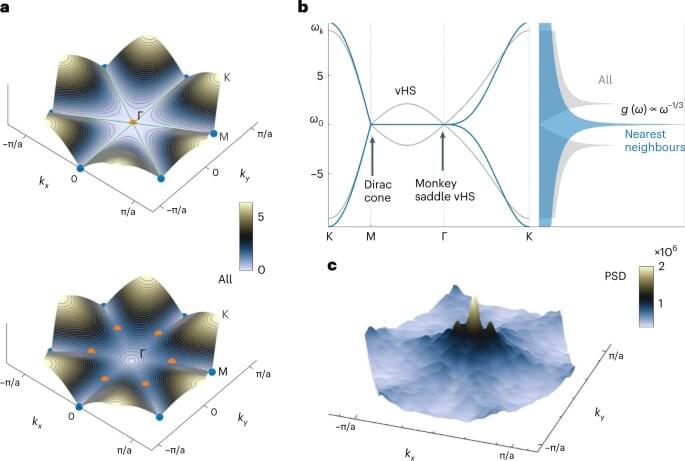Twelve-hour (12 h) ultradian rhythms are a well-known phenomenon in coastal marine organisms. While 12 h cycles are observed in human behavior and physiology, no study has measured 12 h rhythms in the human brain. Here, we identify 12 h rhythms in transcripts that either peak at sleep/wake transitions (approximately 9 AM/PM) or static times (approximately 3 PM/AM) in the dorsolateral prefrontal cortex, a region involved in cognition. Subjects with schizophrenia (SZ) lose 12 h rhythms in genes associated with the unfolded protein response and neuronal structural maintenance. Moreover, genes involved in mitochondrial function and protein translation, which normally peak at sleep/wake transitions, peak instead at static times in SZ, suggesting suboptimal timing of these essential processes.
You can grasp a hand. You can also grasp a concept. One is literal. One is metaphorical. Our brains know the difference, but would we be able to understand the latter without the former?
Previous studies have suggested that our understanding of metaphors may be rooted in our bodily experience. Some functional MRI, o fMRI, brain imaging studies have indicated, for example, that when you hear a metaphor such as “she had a rough day,” regions of the brain associated with tactile experience are activated. If you hear, “he’s so sweet,” areas associated with taste are activated. And when you hear action verbs used in a metaphorical context, like “grasp a concept,” regions involved in motor perception and planning are activated.
A study by University of Arizona researcher Vicky Lai, published in the journal Brain Research, builds on this research by looking at when, exactly, different regions of the brain are activated in metaphor comprehension and what that tells us about the way we understand language.
Starting with the emergence of quantum mechanics, the world of physics has been divided between classical and quantum physics. Classical physics deals with the motions of objects we typically see every day in the macroscopic world, while quantum physics explains the exotic behaviors of elementary particles in the microscopic world.
Many solids or liquids are composed of particles interacting with one another at close distances, which sometimes results in the rise of “quasiparticles.” Quasiparticles are long-lived excitations that behave effectively as weakly interacting particles. The idea of quasiparticles was introduced by the Soviet physicist Lev Landau in 1941, and ever since has been highly fruitful in quantum matter research. Some examples of quasiparticles include Bogoliubov quasiparticles (i.e. “broken Cooper pairs”) in superconductivity, excitons in semiconductors, and phonons.
Examining emergent collective phenomena in terms of quasiparticles provided insight into a wide variety of physical settings, most notably in superconductivity and superfluidity, and recently in the famous example of Dirac quasiparticles in graphene. But so far, the observation and use of quasiparticles have been limited to quantum physics: in classical condensed matter, the collision rate is typically much too high to allow long-lived particle-like excitations.
Tech giants from Google to Amazon and Alibaba —not to mention nation-states vying for technological supremacy—are racing to dominate this space. The global quantum-computing industry is projected to grow from $412 million in 2020 to $8.6 billion in 2027, according to an International Data Corp. analysis.
Whereas traditional computers rely on binary “bits”—switches either on or off, denoted as 1s and 0s—to process information, the “qubits” that underpin quantum computing are tiny subatomic particles that can exist in some percentage of both states simultaneously, rather like a coin spinning in midair. This leap from dual to multivariate processing exponentially boosts computing power. Complex problems that currently take the most powerful supercomputer several years could potentially be solved in seconds. Future quantum computers could open hitherto unfathomable frontiers in mathematics and science, helping to solve existential challenges like climate change and food security. A flurry of recent breakthroughs and government investment means we now sit on the cusp of a quantum revolution. “I believe we will do more in the next five years in quantum innovation than we did in the last 30,” says Gambetta.
But any disrupter comes with risks, and quantum has become a national-security migraine. Its problem-solving capacity will soon render all existing cryptography obsolete, jeopardizing communications, financial transactions, and even military defenses. “People describe quantum as a new space race,” says Dan O’Shea, operations manager for Inside Quantum Technology, an industry publication. In October, U.S. President Joe Biden toured IBM’s quantum data center in Poughkeepsie, N.Y., calling quantum “vital to our economy and equally important to our national security.” In this new era of great-power competition, China and the U.S. are particularly hell-bent on conquering the technology lest they lose vital ground. “This technology is going to be the next industrial revolution,” says Tony Uttley, president and COO for Quantinuum, a Colorado-based firm that offers commercial quantum applications. “It’s like the beginning of the internet, or the beginning of classical computing.”
Researchers at Stanford Medicine have shown they can measure thousands of molecules — some of which are signals of health — from a single drop of blood.
The new approach combines a microsampling device — a tool used to self-administer a finger prick — with “multi-omics” technologies, which simultaneously analyze a vast array of proteins, fats, by-products of metabolism and inflammatory markers.
“Even more importantly, we’ve shown you can collect the blood drop at home and mail it into the lab,” said Michael Snyder, PhD, director of the Center for Genomics and Personalized Medicine and senior author on the research, which was published in Nature Biomedical Engineering on Jan. 19.
Year 2014 Essentially this could scan blood very quickly compared to older outdated methods with mass spectrometry.
Rapid identification of the causative microorganism is important for appropriate antimicrobial therapy of bloodstream infections. Bacteria from positive blood culture (BC) bottles are not readily available for identification by matrix-assisted laser desorption ionization—time of flight mass spectrometry (MALDI-TOF MS). Lysis and centrifugation procedures suggested for direct MALDI-TOF MS from positive BCs without previous culture are associated with additional hands-on processing time and costs. Here, we describe an alternative approach applying MALDI-TOF MS from bacterial cultures incubated very briefly on solid medium. After plating of positive BC broth on Columbia blood agar (n = 165), MALDI-TOF MS was performed after 1.5, 2, 3, 4, 5, 6, 7, 8, 12 and (for control) 24 h of incubation until reliable identification to the species level was achieved (score ≥2.0). Mean incubation time needed to achieve species-level identification was 5.9 and 2.0 h for Gram-positive aerobic cocci (GPC, n = 86) and Gram-negative aerobic rods (GNR, n = 42), respectively. Short agar cultures with incubation times ≤2, ≤4, ≤6, ≤8 and ≤12 h yielded species identification in 1.2%, 18.6%, 64.0%, 96.5%, 98.8% of GPC, and in 76.2%, 95.2%, 97.6%, 97.6%, 97.6% of GNR, respectively. Control species identification at 24 h was achieved in 100% of GPC and 97.6% of GNR. Ethanol/formic acid protein extraction performed for an additional 34 GPC isolates cultivated from positive BCs showed further reduction in time to species identification (3.1 h). MALDI-TOF MS using biomass subsequent to very short-term incubation on solid medium allows very early and reliable bacterial identification from positive BCs without additional time and cost expenditure.
The Kardashev scale measures a society’s technical development based on its capacity to capture energy. In 1964, the Russian astronomer Nikolai Kardashev proposed this system of measurement. The imagined scale of energy consumption is universal and includes the entire universe. Other proposals have been put forward for updating the scale since 1964, including additional power levels and criteria beyond just power itself. In a study presented at the Byurakan conference, a science gathering whose aim was discussing the Soviet Union’s space listening program for radio astronomy, Kardashev initially proposed the concept of his scale. Subscribing to our YouTube channel will provide you access to exclusive content regarding extraterrestrial civilization. Your participation in the form of shares, likes, and comments is greatly appreciated. Please don’t be shy about chiming in with your thoughts and inquiries; we welcome them all.
Subscribe for more! ► https://bit.ly/2Q64mGd.
Credit: NASA, ESA, ESO, SpaceX, Wikipedia, Shutterstock,… #TheSimplySpaceEN …
#TheSimplySpaceEN
ABOVE: © ISTOCK.COM, DR_MICROBE
Mycoplasma pneumoniae are tiny bacteria typically known to cause lung infections. But now, a group of scientists have turned them into double agents. Genetically engineered Mycoplasma helped break down biofilms of another pathogenic microbe, Pseudomonas aeruginosa, in a mouse model of ventilator-associated pneumonia and on tube samples taken from human patients, the team reported January 19 in Nature Biotechnology. It is one of the first times that scientists have used live bacteria to treat a lung disease, and is the first therapeutic use of Mycoplasma.
“This approach is really powerful,” says Dave Hava, a microbiologist who wasn’t involved in the research, but who works at a company called Synlogic that develops live bacteria therapeutics for gut issues. “It offers the chance to target diseases and mechanisms that you can’t do with conventional therapies.”
Health tests and reports suggest that Bryan Johnson, 45, has the heart of a 37-year-old and gets erections like a teenager, Bloomberg reported.
From the Jupiter Icy Moons Explorer to the return to Earth of an asteroid explorer to India’s first India’s private space launch, 2023 is set to be as busy a space exploration year as 2022. Here’s a preview.








